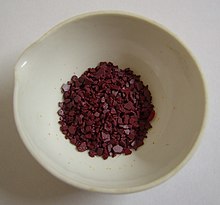Chromium (VI) oxide
| Crystal structure | ||||||||||||||||
|---|---|---|---|---|---|---|---|---|---|---|---|---|---|---|---|---|

|
||||||||||||||||
| __ Cr 6+ __ O 2− | ||||||||||||||||
| General | ||||||||||||||||
| Surname | Chromium (VI) oxide | |||||||||||||||
| other names |
|
|||||||||||||||
| Ratio formula | CrO 3 | |||||||||||||||
| Brief description |
dark red, odorless crystal needles |
|||||||||||||||
| External identifiers / databases | ||||||||||||||||
|
||||||||||||||||
| properties | ||||||||||||||||
| Molar mass | 99.99 g · mol -1 | |||||||||||||||
| Physical state |
firmly |
|||||||||||||||
| density |
2.7 g cm −3 (20 ° C) |
|||||||||||||||
| Melting point |
197 ° C |
|||||||||||||||
| boiling point |
Decomposition above 200 ° C |
|||||||||||||||
| solubility |
very good in water (1854 g l −1 at 20 ° C) |
|||||||||||||||
| safety instructions | ||||||||||||||||
|
||||||||||||||||
| Authorization procedure under REACH |
of particular concern : carcinogenic, mutagenic ( CMR ); subject to approval |
|||||||||||||||
| MAK |
|
|||||||||||||||
| Toxicological data | ||||||||||||||||
| As far as possible and customary, SI units are used. Unless otherwise noted, the data given apply to standard conditions . | ||||||||||||||||
Chromium (VI) oxide , also known as chromium trioxide (CrO 3 ), is an oxide of chromium . It is a dark red solid that is hygroscopic and easily soluble in water . The aqueous solution is strongly acidic ( chromic acid ). The substance poses a number of dangers.
properties
Chromium (VI) oxide forms red-violet, odorless, needle-shaped crystals. It dissolves in a lot of water to form yellow chromic acid (H 2 CrO 4 ). Condensed chromic acids are also formed in a little water. When chromium (VI) oxide is glowing, it decomposes and forms chromium (III) oxide and oxygen :
Chromium (VI) oxide is a very good oxidizing agent that z. B. reacts explosively with ethanol or other organic substances.
The crystal structure of chromium (VI) oxide consists of chains of corner-linked tetrahedra that are clearly distorted in the direction of the chain.
Synthesis / representation
Chromium (VI) oxide is produced by precipitation from a concentrated chromate solution with concentrated sulfuric acid.
use
In electroplating , in wood preservatives , for the production of chromium (IV) oxide , potassium dichromate and ammonium dichromate , as a strong oxidizing agent ( Jones oxidation ).
Chromium VI is or has been used in the case of unprofessional tanning .
safety instructions
Chromium (VI) oxide is fire-promoting and increases the risk of fire if it comes into contact with flammable substances. Mixing with flammable substances poses a risk of explosion. Chromium (VI) oxide is very toxic and is both mutagenic and carcinogenic . As little as 0.6 g taken orally can be fatal. If swallowed, digestive disorders, kidney damage, cramps and paralysis are the result. Aqueous solutions of chromium (VI) oxide are highly corrosive. The solid also leads to severe burns on contact with skin and mucous membranes . Chromium (VI) oxide is dangerous for the environment and extremely hazardous to water ( water hazard class 3).
Individual evidence
- ↑ a b c d e f g h Entry on chromium (VI) oxide in the GESTIS substance database of the IFA , accessed on February 1, 2016(JavaScript required) .
- ↑ Entry on Chromium trioxide in the Classification and Labeling Inventory of the European Chemicals Agency (ECHA), accessed on February 1, 2016. Manufacturers or distributors can expand the harmonized classification and labeling .
- ↑ Entry in the SVHC list of the European Chemicals Agency , accessed on July 16, 2014.
- ↑ Entry in the register of substances subject to authorization of the European Chemicals Agency , accessed on July 16, 2014.
- ↑ Swiss Accident Insurance Fund (Suva): Limits - Current MAK and BAT values (search for 1333-82-0 or chromium (VI) oxide ), accessed on October 27, 2015.
- ↑ a b c Data sheet chromium (VI) oxide (PDF) from Merck , accessed on January 19, 2011.
- ^ JS Stephens, DWJ Cruickshank: The Crystal Structure of (CrO 3 ) ∞ in: Acta Cryst. , 1970 , B26 , pp. 222-226; doi : 10.1107 / S0567740870002182
- ↑ Unlimited animal transport. Retrieved February 21, 2020 .






